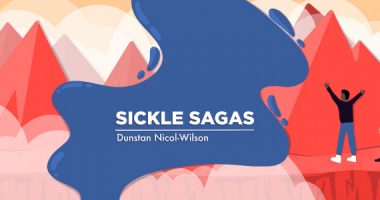Top 10 Sickle Cell Disease Stories of 2020

Sickle Cell Disease News brought you daily coverage of key findings, treatment developments, clinical trials, and other important events related to sickle cell disease (SCD) throughout 2020, a year marked by the COVID-19 pandemic.
As a reminder of what mattered most to you in 2020, here are the top 10 most-read articles of last year with a brief description of what made them interesting and relevant to the SCD community.
We look forward to reporting more relevant news to patients, family members, and caregivers dealing with SCD during 2021.
No. 10 – “GBT Supports Sickle Cell Patients During COVID-19 Pandemic”
Global Blood Therapeutics (GBT), the developer of Oxbryta (voxelotor) — the first approved treatment targeting SCD’s underlying cause — announced in March a series of proactive measures to prevent the spread of COVID-19 and support SCD patients.
To lower virus transmission and support public health efforts, the company decided to temporarily replace in-person visits to physicians, clinics, hospitals, and payers/insurers with digital communication and online education.
GBT also assured patients that it had enough Oxbryta supply to sustain patients’ needs until 2021, and that its Oxbryta support program, called GBT Source, remained available to help with new enrollments and reimbursement, as well as to provide financial, co-pay, treatment adherence, and refill support.
No. 9 – “Hematology Society Releases Guidelines for Blood Transfusions in SCD”
That same month, we reported the release of new clinical guidelines from the American Society of Hematology for the use of blood transfusions in people with SCD.
Developed by an interdisciplinary panel of clinicians, researchers, and patient representatives, the recommendations provide guidance on the specific indications and administration modes for blood transfusions, as well as on the prevention and management of associated complications.
These include recommendations to perform extended blood type matching to prevent immune responses following a transfusion, and the use of immunosuppressive treatments in SCD patients who have, or are at risk of having, such responses.
The panel noted, however, that most of these guidelines were “conditional,” as available evidence had a low or very low certainty degree, and that they may be associated with an increased financial burden and healthcare resource use.
No. 8 – “Smartphone App May Help Assess Anemia Using Eyelid Pictures”
Researchers at Purdue University, in Indiana, are developing a smartphone app that can measure hemoglobin levels, with a high level of accuracy, by analyzing images of a person’s inner eyelid. Hemoglobin is the protein in red blood cells responsible for transporting oxygen and that is defective in SCD patients.
Since the inner eyelid is rich in small blood vessels and lacks skin pigmentation, evaluating its redness provides a quick way to assess whether a person may have anemia. The app’s already tested software relies on an algorithm that estimates hemoglobin levels based on the way it absorbs visible light.
While the future app won’t replace a conventional blood test, it may provide a near-accurate hemoglobin count in real-time and in a non-invasive way, allowing better disease control in people with SCD and other blood disorders. These advantages may be even more relevant in developing countries without adequate laboratory infrastructures.
No. 7 – “Sickle Cell Association Issues COVID-19 Guidelines for US Reopening”
An advisory committee of the Sickle Cell Disease Association of America issued a list of recommendations for SCD patients during the country’s reopening, which officially started on May 1.
These were based on the U.S. Coronavirus Taskforce’s guidelines for those deemed “vulnerable” to COVID-19 infection, which the committee believes includes SCD patients, and were meant to be followed until routine activities were deemed safe by state and local authorities.
The recommendations included remaining at home as much as possible, working remotely, and practicing social distancing. If working remotely was not possible, patients should be provided with masks, hand sanitizers, and strategies to ensure appropriate social distancing.
SCD patients were also recommended to continue their medications as prescribed by their doctors and to maintain communication with their healthcare providers through telemedicine or telephone consultations.
No. 6 – “Bluebird Bio Presents Data from LentiGlobin Gene Therapy Trial”
Interim results from the ongoing HGB-206 Phase 1/2 clinical trial (NCT02140554) showed that LentiGlobin, Bluebird Bio’s investigational gene therapy, was generally safe and prevented serious vaso-occlusive crises (VOCs) and acute chest syndrome in adolescents and adults with severe SCD.
The data concerned 34 patients who were followed from three months to up to three years, including 25 who underwent an improved treatment protocol and remained without a need for regular blood transfusions after three months.
LentiGlobin uses a modified and harmless virus to deliver an improved, functional copy of HBB — the mutated gene in SCD — to a patient’s red blood cell precursors. The approach promotes the production of an anti-sickling form of hemoglobin in red blood cells, preventing their destruction and other SCD complications.
BlueBird is still recruiting SCD patients, ages 2 to 50, for its U.S.-based, Phase 3 trial of LentiGlobin (NCT04293185); more information on contacts and locations can be found here.
No. 5 – “FDA Names Potential Gene Therapy for Sickle Cell an ‘Orphan Drug,’ Aruvant Announces”
In January, the U.S. Food and Drug Administration (FDA) granted orphan drug status to Aruvant’s gene therapy candidate ARU-1801 for the treatment of SCD. The therapy was designated a rare pediatric disease by the agency a few weeks earlier. These designations are meant to expedite ARU-1801’s clinical development and review.
ARU-1801 is currently the only virus-based gene therapy that delivers a modified and optimized version of the fetal hemoglobin gene in clinical testing. Fetal hemoglobin is a form of hemoglobin produced during fetal development that is more effective at transporting oxygen than its adult counterpart.
The therapy is being assessed in a Phase 1/2 trial (NCT02186418) that may still be recruiting up to 10 adults with SCD, ages 18 to 45, at sites in the U.S., Canada and Jamaica. Contact and other information is available here.
No. 4 – “First SCD Patient Treated With CTX001 Remains VOCs-free After 9 Months, Trial Results Show”
Positive findings from the first patient with severe SCD given a single dose of CTX001, an experimental gene-editing therapy co-developed by CRISPR Therapeutics and Vertex Pharmaceuticals, were reported over the summer.
The therapy uses the CRISPR-Cas9 gene-editing tool to modify patients’ blood cell progenitors so that they produce high levels of fetal hemoglobin in red blood cells.
Nine-month data from the CLIMB-SCD-121 Phase 1/2 trial (NCT03745287) showed that CTX001 safely and effectively prevented VOCs and the need for blood transfusions in the first treated patient, a 33-year-old woman. It also increased her fetal hemoglobin levels and the number of fetal hemoglobin-containing red blood cells. This trial may still be enrolling at sites in the U.S., Europe and Canada; information is available here.
No. 3 – “Sickle Cell Patient Describes ‘Rebirth’ After Gene Therapy”
In January, Sickle Cell Disease News reported the story of 39-year-old Charles Hough, who said he had a “new chance at life” after receiving LentiGlobin.
He shared his story in a webinar, explaining how after overhearing a conversation about a SCD clinical trial at the National Institutes of Health in Bethesda, Maryland, he entered the same trial in 2017 and received the gene therapy about 18 months later.
While the required single chemotherapy session (to ensure his body would not reject the modified cells) took a heavy toll on his mental and physical health, Hough is now living “a healthy, full life without any complications.”
No. 2 – “Phase 1/2 Trial of Gene-editing Therapy for SCD Cleared by FDA”
In an April story, we reported FDA’s clearance for the start of a Phase 1/2 clinical trial (NCT04443907) testing another experimental gene-editing therapy, known as OTQ923, in adults with severe SCD complications.
The study will, in fact, evaluate the safety and effectiveness of two gene-editing therapies — OTQ923 and HIX763 — discovered through a collaboration between Intellia Therapeutics and Novartis, which is sponsoring the trial.
Both therapies use the CRISPR-Cas9 gene-editing tool to promote the production of fetal hemoglobin in blood precursor cells collected from a patient.
The three-part trial may still be recruiting up to 20 people, ages 2 to 40, with severe SCD complications at its single clinical site in Tennessee. Part A will include adults treated with OTQ923, part B includes adults treated with HIX763, and part C will involve children up to 17 years old, who will receive either OTQ923 or HIX763 depending on earlier trial results.
No. 1 – “World Sickle Cell Day Celebrates Patients, Raises Awareness”
Our most-read article of 2020 concerned our coverage of several campaigns and actions to raise awareness about SCD and funds to fight it on the World Sickle Cell Day, observed each June 19.
The U.K.-based Sickle Cell Society encouraged patients and supporters to wear red (the official SCD color), create fundraising events involving walks or runs, shave or dye their hair, teach an online class, and to share patient stories and fundraising activities with local media outlets.
Through a phone interview with Mapillar Dahn, the mother of three girls living with SCD, and Amatullah Tyler, her oldest daughter, we also reported the struggles of a family affected by SCD.
Inspired by her daughters, Dahn founded the MTS Sickle Cell Foundation — MTS stands for “My Three Sicklers” — to raise awareness, assist in education and research, and provide support for affected families. Funded by individuals and companies, including GBT, the foundation was also able to help more than 500 families affected by the COVID-19 pandemic.
***
At Sickle Cell Disease News we hope these stories and our reporting throughout 2021 help to better inform and improve the lives of everyone affected by SCD.
We wish all our readers a happy 2021.






